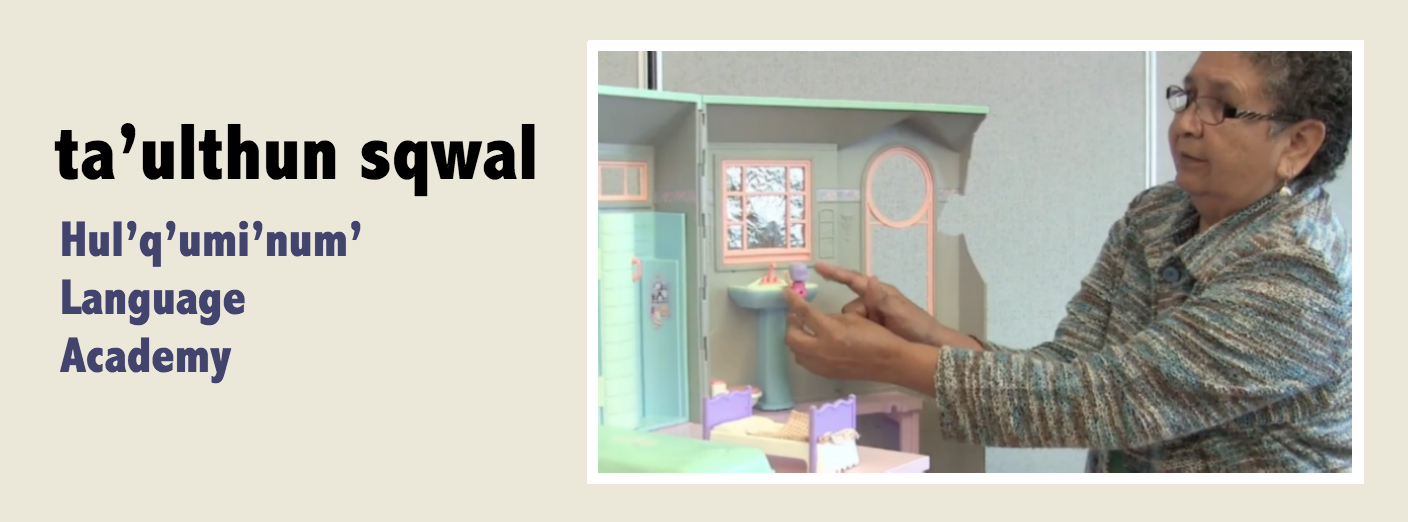

mallard – tunuqsun
[Anas platyrhynchos Linnaeus] • Mallards are common ducks that often become tame where they have regular contact with humans, such as in cities and towns. The male mallard has a greyish body, chestnut breast, white neck ring and distinctive green head. The female is mottled brown with a white tail. Mallards are a traditional food.
yusul’iws tunuqsun yu lhalhukw’.
There are two mallards flying.
yu stslhal’we’lh tthu swuy’qe’ ’i’ hay thu slheni’ tunuqsun ni’ yu stl’pal’we’lh kwsus yu lhalhukw’.
The male is on top and the female mallard is underneath as they are flying.
nuts’tul tthu tunuqsun ’u tthu swuy’qe’ ’i’ thu slheni’ tunuqsun.
The male and female mallards are different.
tthu swuy’qe’ tunuqsun ’i’ tsqway tthu sxuy’usth, p’uq’ tthu shxwuxwqw’nulhs, ’i’ tuw’ tumlhalus tthu smustimuhws, ’i’ hay tthu t’e’luw’s ts-hwikw’alus.
The male has a green head, a white necklace, and a brown body, and its wings are greyish.
thu slheni’ tunuqsun ’i’ tthu sxuy’usth hwihwukw’ul’ tumlhalus, ’i’ hay tthu
smustimuhws tuw’ st’ul’t’el’q’.
The female mallard has a greyish head and a brown body that’s spotted.
yu s-xwal’qw’ tthu smustimuhws kwus ’uw’ yuse’lu ’u tthu p’uq’.
Their bodies have two white stripes.
yu sthuthekw’ tthu sxun’us yu sp’li’q’ ’u tthu shtl’upi’snutss.
Their legs are straightened out and tucked to their bottoms.
ha’ ni’ shhwunem’ tthu tunuqsun, ’i’ nilh tthu shqwultuns nilh ni’ he’kw’me’tus tthu mustimuhw, ’uw’ hay thu slheni’ ma’uqw tunuqsun, ni’ ch qwultun ’u tthukwex kwex kwex.
If you hear the mallard, the call that people remember, that’s the female mallard, duck, and you hear the, “quack, quack, quack.”
ni’ st’ee kw’ ’apun kwsus hunum’ust-hwus tthu shqwultuns, hwthiqun ’u tthuw’ hwun’a’ ’i’ ni’ hwu hwsuw’weem’qun kwus yu hunum’ust-hwus tthu swe’s shqwultuns.
Her calls around ten time, first loudly and then getting softer.
’i’ hay tthu swuy’qe’ tunuqsun ni’ tl’uw’ hwnuts’qun, ni’ st’ee ’uw’ niis tuw’ xet’kw’um’, xxxx, xxxx, xxxx.
And as for the male mallard, his call is different, like a rasping sound, gh gh gh gh.
yu ’a’hwul’muhw tthu tunuqsun.
The mallards live as couples.
tthu ma’uqw tunuqsun ’i’ yath ’uw’ yu stutes ’u thu qa’—kwthu xa’tsa’, sta’luw’, lhil’lhul’q tumuhw, ’i’ kwthu tl’elhum qa’.
Mallards are always near the water—lakes, rivers, wetlands, and the salt water.
tthu s’ulhtuns tthu tunuqsun ’i’ qux kwus nuts’tul, nilh tthu ni’ sheshum’ qa’—ts’its’usum’ ni’ ’u tthu tl’itl’up nilh ni’ s’ulhtuns— squli’qum’kwa’la’, ’i’ tthu stth’ukw’.
Mallards get a lot of different foods in the shallow water—food that’s growing down below, fingerlings, and worms.
[’i’ ni’] lheyxtus tthu ts’its’usum’ ni’ ’u tthu tl’itl’up, sus m’uw’ thuy’qwtus ’i’ ni’ lhey’xtus.
They come eat what’s growing underwater, and they dig up it up and eat it.
ts’uhwle’ ’i’ ni’ hwi’ hwmatqwusum’ tthu tunuqsun, ’i’ ’uw’ t-hway ’ul’ tthu shtl’upi’snutss ni’ swi’wul’.
Sometimes mallards dunk their faces in the water, and then only their bottoms are showing.
nilh ni’ tl’uw’ ’uy’st-hwus thu tul’itnuqsun’ tthu lhul’a’lhukw’—xwi’xwuy’a’yu, tth’utth’sh.
The ducklings like (to eat) flying things, such as flies and dragon flies.
ni’ tthu tunuqsun ’uwu kwlh nem’ huye’, ’uw’ ’i’ ’ul’ ’u tun’a ’u kwsus tum’xuy’tl’.
Some mallards don’t ever leave, but some stay here during the winter.
qux kwthu ni’ huye’num’ tuyqul nem’ ’u kwthu kw’e’lus tumuhw, ’u kwsus tum’xuy’tl’.
Many manage to move to the warmer locations in the wintertime.
hay ’ul’ tsakw ni’ shhwunum’s tthu tunuqsun ’u kwsus wulh tum’xuy’tl’.
The mallards migrate long distances during the winter.
’i’ kwsus wulh m’i kw’asthut ’i’ m’i tetsul.
When it warms up, they arrive.
nilh hay ’ul’ ’uy’st-hwus tthu hwulmuhw tthu ma’uqw tunuqsun, ’uy’ s’ulhtuns.
The First Nations people really like mallards, it’s good food.
niilh saay’stum’ tthu xut’ustum’ hwul’hwul’u ’i’ st’i’am’ tthu swultun.
They would prepare what was called duck net pole with a net attached.
nilh niilh ha’kwushus tthu hwulmuhw kwsus ’a’luxutum’ tthu ma’uqw.
This is what the First Nations people used to collect the ducks.
ni’ lhakw’ ’i’ ni’ hwu sun’iw’ ’u tthey’ hwul’hwul’u, swultun.
They flew into that net trap.
tun’a kweyul ’i’ nilh tthu skw’ul’esh ni’ hwu ha’kw, xut’ustum’ shotgun.
Today they use guns, the shotguns.
niilh qw’umuwstum tthu ma’uqw tunuqsun.
The mallards were plucked and singed on the fire.
ni’ hwu sqw’um’iw’s ’i’ ni’ hwi’ skw’siws ni’ ’u tthu huy’qw.
The mallards were plucked and singed on the fire.
nilh hay ’ul’ ’uy’ s’ulhtuns tthu hwulmuhw.
That’s very good food for the First Nations people.
__________
Hul’q’umi’num’ description by Ruby Peter | Sti’tum’at and Donna Gerdts | Sp’aqw’um’ultunaat


